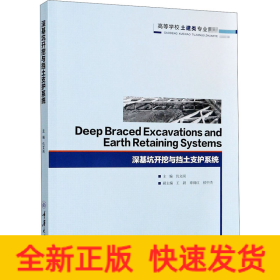
深基坑开挖与挡土支护系统
全新正版 极速发货
¥ 28.03 4.8折 ¥ 59 全新
仅1件
广东广州
认证卖家担保交易快速发货售后保障
作者仉文岗 编
出版社重庆大学出版社
ISBN9787568920186
出版时间2020-04
装帧平装
开本16开
定价59元
货号1202171775
上书时间2024-06-08
- 最新上架
商品详情
- 品相描述:全新
- 商品描述
-
作者简介
仉文岗,Prof Wengang Zhang is full professor of Geotechnical Engineering in School ofCivil Engineering, Chongqing University. He graduated from NanyangTechnological University, Singapore in 2014 and was the recipient of theOverseas High-level Talent (Young Thousand Talented Professor) in 2017.He now serves the school as the Associate Chair, in charge ofinternationalization. His research areas mainly include numerical modelling indeep braced excavation, reliability analysis, and soft computing and big datageotechnical analysis. Prof. Zhang has published 46 papers in internationaljournals as the main author and one book about big data with Springer. He wasalso the recipient of Computers and Geotechnics 2019 Sloan OutstandingPaper Award. The paper he published in GSF titled "Multivariate adaptiveregression splines and neural network models for prediction of pile drivability"is also among the top three papers with the highest citations.
目录
1 Overview
2 Overall Stability
2.1 Introduction
2.2 Types of Factors of Safety
2.3 Basal Heave Stability
2.4 Push-in Stability
2.5 Overall Shear Failure of Cantilever Walls
3 Earth Pressure and Strut Force
3.1 Introduction
3.2 Lateral Earth Pressure in Braced Excavations
3.3 Parametric Study
3.4 One-Strut Failure Analysis
4 Retaining Wall and Bending Moment
4.1 Introduction
4.2 Wall Types
4.3 Stress Analysis Method
4.4 Design of Retaining Walls
5 Ground Movements
5.1 Introduction
5.2 Sources of Ground Movements
5.3 Ground Movement Predictions Adjacent to Excavations
5.4 Damage to Buildings
6 Finite Element Method
6.1 Introduction
6.2 Basic Principles
6.3 Determination of Initial Stresses
6.4 Modeling of an Excavation Process
6.5 Mesh Generation
6.6 Excavation Analysis Method
6.7 Example: Excavation in Sand
7 Soll Constitutive Models
7.1 Introduction
7.2 Linear Elastic Perfectly Plastic Model (Mohr-Coulomb Model)
7.3 Hardening Soil Model (Isotropic Hardening)
7.4 Hardening Soil Model with Small-strain Stiffness (HS-small)
7.5 The Soft Soil Model
7.6 Modified Cam-Clay Model
8 Dewatering of Excavations
8.1 Introduction
8.2 Dewatering Methods
8.3 Well Theory
8.4 Pumping Test
8.5 Dewatering Plan for an Excavation
8.6 Dewatering and Ground Settlement
9 Soil Improvement by Grouting
9.1 Introduction
9.2 Grouting Equipment
9.3 Grouting Methods
9.4 Ground Improvement Design
10 Adjacent Building Protection
10.1 Introduction
10.2 Building Protection by Utilizing the Characteristics of Excavation-induced Deformation
10.3 Building Protection by Utilizing Auxiliary Methods
10.4 Building Rectification Methods
11 Instrumentation and Monitoring
11.1 Introduction
11.2 Element of a Monitoring System
11.3 Measurement of Movement
11.4 Measurement of Stress and Force
11.5 Measurement of Water Pressure and Groundwater Level
11.6 Plan of Monitoring Systems
11.7 Application of Monitoring Systems
12 Back Analysis for Excavation
12.1 Introduction
12.2 General Procedure of Back Analysis in Excavation Issues
12.3 Deterministic Method
12.4 Probabilistic Methods
13 Excavation Failure Case Analysis
13.1 Introduction
13.2 Nicoll Highway Collapse, Singapore, 2004
13.3 Xianghu Metro Station Collapse, Hangzhou, China, 2008
13.4 Guangzhou Haizhu City Square Foundation Pit Collapse
13.5 Shanghai Metro Line 4 Seepage
13.6 Other Cases
Appendix
Appendix I Symbols and Abbreviations
Appendix II Database of Propped and Anchored Deep Excavation
Reference
内容摘要
Deep Braced Excavations and Earth Retaining Systems collects the selected publications on deep braced excavation from the Editor. Apart from that, it also contains the basic design theories and principles in analysis of basal heave stability, toe stability, strut forces, retaining wall and ground deformations, auxiliary measures and instrumentation, observation methods and back analysis, etc. Aimed at both theoretical explication and practical application, this book covers a large scope. From basic to advanced, it tries to attain theoretical rigorousness and consistency. Each chapter is followed by problems and solutions so that the book can be readily taught at senior undergraduate and graduate including PhD students. Professors, research students, design engineers as well as staff work for consultation in the field of civil engineering, espely geoteehnical engineering can benefit from the book.
相关推荐
— 没有更多了 —



















以下为对购买帮助不大的评价